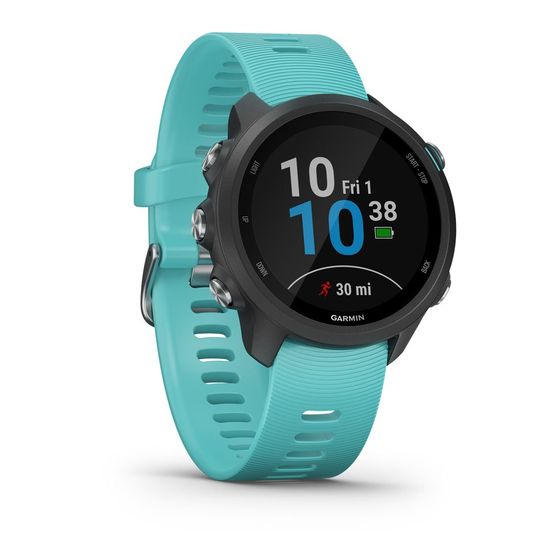Garmin FORERUNNER 245 Panduan Pemilik - Halaman 18
Jelajahi secara online atau unduh pdf Panduan Pemilik untuk Menonton Garmin FORERUNNER 245. Garmin FORERUNNER 245 40 halaman.

from your other Garmin devices appear on your Forerunner
device.
Training Status
Training status shows you how your training affects your fitness
level and performance. Your training status is based on changes
to your training load and VO2 max. over an extended time
period. You can use your training status to help plan future
training and continue improving your fitness level.
Peaking: Peaking means that you are in ideal race condition.
Your recently reduced training load is allowing your body to
recover and fully compensate for earlier training. You should
plan ahead, since this peak state can only be maintained for
a short time.
Productive: Your current training load is moving your fitness
level and performance in the right direction. You should plan
recovery periods into your training to maintain your fitness
level.
Maintaining: Your current training load is enough to maintain
your fitness level. To see improvement, try adding more
variety to your workouts or increasing your training volume.
Recovery: Your lighter training load is allowing your body to
recover, which is essential during extended periods of hard
training. You can return to a higher training load when you
feel ready.
Unproductive: Your training load is at a good level, but your
fitness is decreasing. Your body may be struggling to
recover, so you should pay attention to your overall health
including stress, nutrition, and rest.
Detraining: Detraining occurs when you are training much less
than usual for a week or more, and it is affecting your fitness
level. You can try increasing your training load to see
improvement.
Overreaching: Your training load is very high and
counterproductive. Your body needs a rest. You should give
yourself time to recover by adding lighter training to your
schedule.
No Status: The device needs one or two weeks of training
history, including activities with VO2 max. results from
running or cycling, to determine your training status.
Tips for Getting Your Training Status
The training status feature depends on updated assessments of
your fitness level, including at least two VO2 max.
measurements per week. Your VO2 max. estimate is updated
after outdoor runs during which your heart rate reached at least
70% of your maximum heart rate for several minutes. The trail
run and indoor run activities do not generate a VO2 max.
estimate in order to preserve the accuracy of your fitness level
trend.
To get the most out of the training status feature, you can try
these tips.
• At least two times per week, run outdoors and reach a heart
rate higher than 70% of your maximum heart rate for at least
10 minutes.
After using the device for one week, your training status
should be available.
• Record all of your fitness activities on this device, or enable
the Physio TrueUp
™
feature, allowing your device to learn
about your performance
Measurements, page
13).
About VO2 Max. Estimates
VO2 max. is the maximum volume of oxygen (in milliliters) you
can consume per minute per kilogram of body weight at your
maximum performance. In simple terms, VO2 max. is an
indication of athletic performance and should increase as your
level of fitness improves. The Forerunner device requires wrist-
14
(Syncing Activities and Performance
based heart rate or a compatible chest heart rate monitor to
display your VO2 max. estimate.
On the device, your VO2 max. estimate appears as a number,
description, and position on the color gauge. On your Garmin
Connect account, you can view additional details about your
VO2 max. estimate, including your fitness age. Your fitness age
gives you an idea of how your fitness compares with a person of
the same gender and different age. As you exercise, your fitness
age can decrease over time.
Purple
Blue
Green
Orange
Red
VO2 max. data is provided by FirstBeat. VO2 max. analysis is
provided with permission from The Cooper Institute
information, see the appendix
page
31), and go to www.CooperInstitute.org.
Getting Your VO2 Max. Estimate for Running
This feature requires wrist-based heart rate or a compatible
chest heart rate monitor. If you are using a chest heart rate
monitor, you must put it on and pair it with your device
Your Wireless Sensors, page
was packaged with a heart rate monitor, the devices are already
paired.
For the most accurate estimate, complete the user profile setup
(Setting Up Your User Profile, page
heart rate
(Setting Your Heart Rate Zones, page
estimate may seem inaccurate at first. The device requires a few
runs to learn about your running performance.
1
Run for at least 10 minutes outdoors.
2
After your run, select Save.
3
Select UP or DOWN to view the performance widget.
4
Select START to scroll through the performance
measurements.
Recovery Time
You can use your Garmin device with wrist-based heart rate or a
compatible chest heart rate monitor to display how much time
remains before you are fully recovered and ready for the next
hard workout.
NOTE: The recovery time recommendation uses your VO2 max.
estimate and may seem inaccurate at first. The device requires
you to complete a few activities to learn about your
performance.
The recovery time appears immediately following an activity.
The time counts down until it is optimal for you to attempt
another hard workout.
Viewing Your Recovery Time
For the most accurate estimate, complete the user profile setup
(Setting Up Your User Profile, page
heart rate
(Setting Your Heart Rate Zones, page
1
Go for a run.
2
After your run, select Save.
The recovery time appears. The maximum time is 4 days.
Superior
Excellent
Good
Fair
Poor
. For more
®
(VO2 Max. Standard Ratings,
(Pairing
21). If your Forerunner device
7), and set your maximum
7). The
7), and set your maximum
7).
Heart Rate Features
